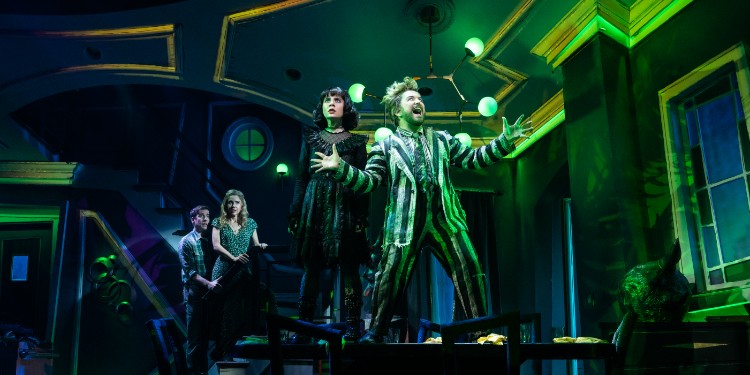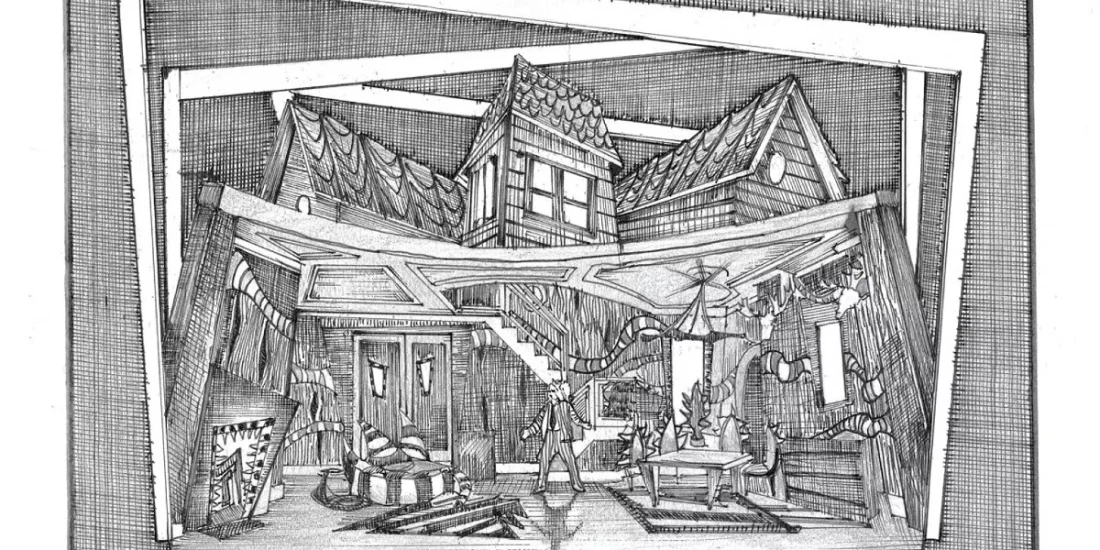Set designer David Korins on why ‘Beetlejuice’ is his most complex set
The Broadway designer talks about how he brought Tim Burton's world to life on stage.
There's something a little bit spooky about Beetlejuice. Sure, the titular Ghost with the Most haunts the Maitlands' house with progressively grander hijinks. And of course, emo teenager Lydia leans into the undead of it all in the musical based on the iconic Tim Burton film. But things got a little eerie off stage as well, as set designer David Korins witnessed.
Korins initially crafted the show's set for the Winter Garden Theatre, where Beetlejuice opened in 2019. Now, the musical has moved to the Marquis Theatre, and as any designer will tell you, a new theatre requires adjustments to the set because no stage is the same size. And for a complicated, meticulously crafted design like Beetlejuice, which is full of special effects, even more so. But not this time.
"If you can believe it — and believe me, I couldn't believe it — the set transferred basically exactly perfect," Korins said. "We got so lucky. I have had the great fortune of doing almost 25 Broadway shows and nothing fits the way you wanted it to fit. It just doesn't. But this one fit."
The Tony-nominated set designer has four shows running on Broadway. In addition to Beetlejuice, Korins also worked on Mrs. Doubtfire, Dear Evan Hansen, and Hamilton. But of all the shows he's worked on, Beetlejuice is by far the most complex, he said.
"I am so, so, so proud that thing exists in the world and that people get to see it, because they're not making theatre like this right now," Korins added, applauding director Alex Timbers for his masterful world creation. "This theatre is bold and powerful and muscular and risky and edgy and stylish and cool and big. I was like, 'Wow, this is a damn incredible thing to like look at.'"
New York Theatre Guide chatted with Korins about what inspired his Beetlejuice design, the Tim Burton easter eggs, and why the set is practically a character in the show.
Get Beetlejuice tickets on New York Theatre Guide.
Tim Burton Easter egg hunt
The first step for creating Beetlejuice was going back to the original auteur: Tim Burton. His iconic film was released in the 1980s, quickly developed a cult following, and laid the foundation for Burton's adventurous filmmaking to come.
"The first thing that you have to do with putting a piece of [intellectual property] on stage is honor where we came from," Korins said. "In this case, we were able to honor Tim Burton as an illustrator and filmmaker and storyteller writ large."
There are "tons" of Burton easter eggs throughout the set, and many of them are in the opening scene at Lydia's mom's funeral. Here are a few of the nods:
- The names on the tombstones are characters from other Tim Burton movies.
- The hills are all sculpted in the style of the Claymation gravestones and the grave in The Nightmare Before Christmas.
"My goal and [director] Alex Timbers's goal was to say, in the very first moment: You are in good hands. We are super fans. We're not going to do some crazy thing that you're not going to know where you are. You're going to be in good hands. We're going to guide you on this journey," Korins said.
Korins describes the film as having a "homemade quality," and he wanted to capture that essence in the textures and design of the set.
"Every single piece of scenery is hand-treated, he said. "The wallpaper is hand-drawn... Every single floorboard is hand-painted. None of it is presenting the way that you think it would be... So there was the technical challenge and there was the artistic challenge."

The House is a character
The set is an integral piece in every play and musical, but in Beetlejuice, the set is an active character.
"The physical structure of the house is a character that, first of all, kills the two main protagonists of the show," Korins said. "It kills them, so there had to be a death situation. And then it becomes the vessel for the entire show to happen within, both upstairs and downstairs. And we get to see the show, that home in three completely different transformed iterations, from the Maitlands to the Deetzes and then ultimately when it gets haunted by Beetlejuice."
So how does one build three houses in one?
"Well, I want to tell you theatre magic, and just shut up about it," Korins said, cheekily.
However, he did share some secrets on how he achieved the "magic."
- The structure of the house - floor, ceiling, and walls - remain the same, but the surfaces of the walls, railings, doors, light fixtures, etc. are all changed out. "It really is a whole new skin, every single thing," he said.
- There are three versions of every piece to accommodate all the versions of the house, and "a group of incredibly well-choreographed, totally game stage crew backstage schlepping the stuff on stage and putting it together live during the show."
Tricks up his sleeve
Korins worked on Beetlejuice for six and a half years, and he started working with director Alex Timbers on the concept before there were even writers for the musical.
"The Beetlejuice set design is by far the most complicated set design by a magnitude of 10 that not only I've ever seen, that I've ever done," he said. "There isn't a piece of scenery that doesn't have a light in it, a special effect, a special trap door for puppetry, smoke, projection surface, speaker, automation, whatever it is. It is unbelievably complicated."
With so many effects and tricks lodged in the Beetlejuice set, we asked Korins to share some of his favorites.
- He loves the puppetry, especially when Beetlejuice is on the roof, and his limbs seemingly multiply with puppeted legs and arms. "Just how the puppets interact with him in that way is so delicious of fun and easy."
- The levitation tricks. "We have two levitation tricks — they happen in two different ways at two different parts of the stage... and one of them happens in full stage light, not even like tricky magic light."
However, it's impossible to list all the ways in which the set creates magic for the show, and Korins relishes being able to use everything he's learned as a designer in the show.
"We have everything: a book falling from the ceiling that then picks up in the footlights, a trap in the floor that two people fall through," he said. "It really is like the kitchen sink of the design lexicon in every category."

Changes for the new space
While the size of the set didn't have to change when the show moved to the Marquis Theatre, Korins did make some changes to the space, as Beetlejuice has an immersive feel to it.
When you walk into the theatre, you immediately feel like you're in the world, and to achieve the vibe, Korins took his designs beyond the stage, blacking out most of the theatre with curtains, switching out the light fixtures with vintage chandeliers, and installing purple and green lightbulbs.
"We've created a really interesting atmosphere in the Marquis," he said. "We did a lot of work to make it our own and make it a new home."
For the fans
The Beetlejuice fans are unlike any other show's, Korins said, and in many ways, the fans kept the show alive, or rather, undead.
Outside the Marquis Theatre, Shubert Alley is covered in fan art and illustrations, demonstrating the impact they've had on the show.
"This show, more than any I've ever been part of, was saved by the fans and was really elevated, kept alive, and then exalted by the fans' voracious love of it," Korins said. "This fan base is so fervent and incredible. I did Hamilton and Dear Evan Hansen, which has some real fans. And this, I got to say the Beetlejuice fans are insane, in the best way. So we have done that because they gave us life so we give them afterlife."
Get Beetlejuice tickets on New York Theatre Guide.
Photo credit: Set sketch of Beetlejuice. (Photo courtesy of David Korins)
Originally published on
